Do you know that most homes in the US use electric stoves for cooking? It’s a popular choice, but it comes with a common problem: electric stove overheating. This issue can make cooking a hassle and even cause dangerous fires. Every year, over 45,000 house fires happen because of problems with cooking equipment. But don’t worry, we will help you fix it.
When your electric stove overheats, it can be frustrating and scary. But with the right information, you can keep your kitchen safe and your cooking experience smooth. That’s why we’re here to help.
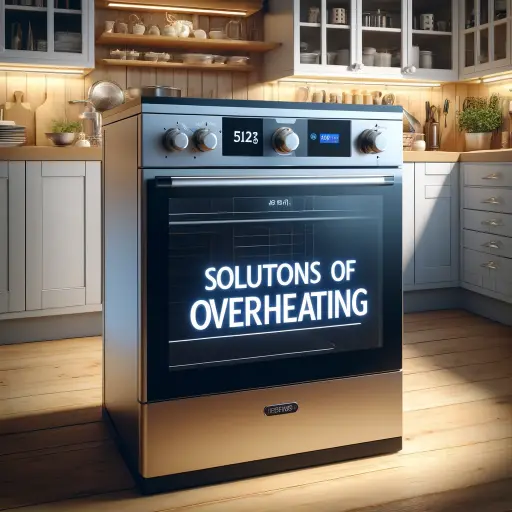
In this post, we’ll delve into effective solutions for electric stove overheating that will help you regain control in your kitchen and ensure a safer cooking environment. From understanding the root causes to implementing preventive measures, We’ll help you understand why it happens and show you easy ways to fix it. So, if you’re tired of dealing with burnt food and worrying about safety in your kitchen, keep reading!
Understanding Electric Stove Overheating
Electric stove overheating occurs when the stove reaches excessively high temperatures during operation, posing various risks to both safety and appliance functionality. The potential risks associated with electric stove overheating include fire hazards, damage to stove components, and even injury to users. It’s essential to address this issue promptly to prevent accidents.
Potential Causes of overheating
There are several common causes of electric stove overheating:
- Overuse: Continuous use of the stove for extended periods without breaks can cause it to overheat due to the constant demand for its heating elements.
- Faulty components: Components such as heating elements or thermostats may malfunction over time, leading to abnormal temperature regulation and overheating.
- Insufficient ventilation: Inadequate airflow around the stove can trap heat and prevent proper cooling, contributing to overheating.
- Cleaning issues: Sometimes, leftover food or spills from cooking can get stuck and block the vents on the stove, causing it to overheat, especially after cleaning.
- Incorrect installation or usage: Improper installation or misuse of the stove, such as placing flammable materials too close to the stove or using it beyond its recommended capacity, can cause overheating.
Identifying Overheating Symptoms
Recognizing signs of an overheating electric stove is crucial for ensuring your safety. Here are some easy-to-spot signs:
Stovetop burner gets too hot
When your stove feels hotter than usual, even when you’re not cooking at high temperatures, it’s a clear indication of overheating. You might feel intense heat coming from the stovetop or oven, making it uncomfortable to touch.
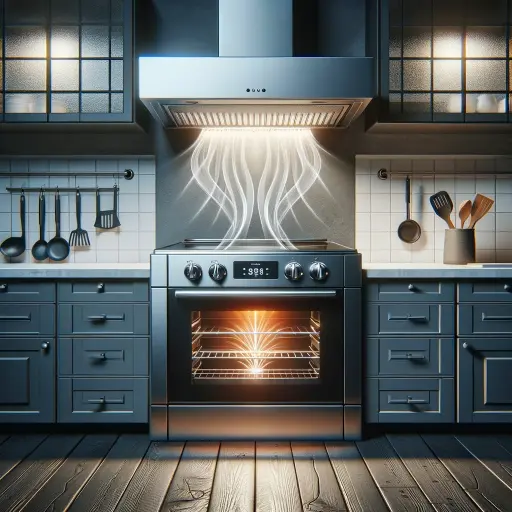
Burnt smell
If you notice a strong burnt smell coming from your stove, it could be a sign that something is overheating. This smell is often a warning sign that you should investigate further.
Uneven cooking or heating
If your dishes come out unevenly cooked, with some parts burnt while others are undercooked, this could be due to uneven heating caused by overheating elements or malfunctioning parts.
Malfunctioning control panel
If the buttons or display screen on your stove act strangely or become too hot to touch, it’s a sign that something is wrong. A malfunctioning control panel can lead to overheating.
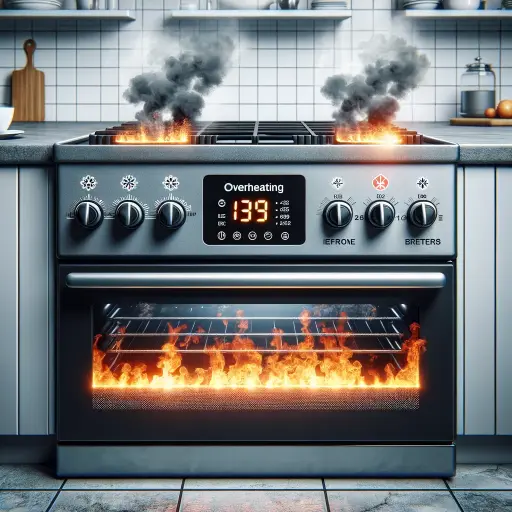
Burn marks or discoloration
Take a close look at your stove’s surface. Do you see any burn marks or discoloration? These could be caused by overheating and indicate that the appliance needs attention to prevent further damage.
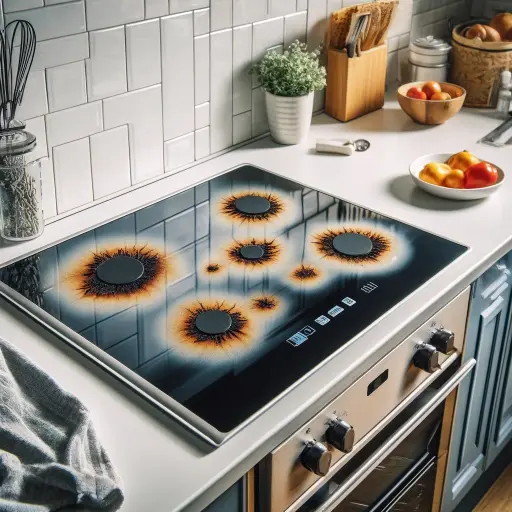
Practical Solutions for Electric Stove Overheating
Ensure Proper Ventilation
- Check vents and airflow pathways around the stove for any blockages or restrictions. Remove any obstructions to facilitate adequate airflow.
- Consider installing or upgrading ventilation systems, such as range hoods or exhaust fans, to improve air circulation and reduce the risk of overheating.
- Arrange kitchen appliances to maximize airflow around the stove area.
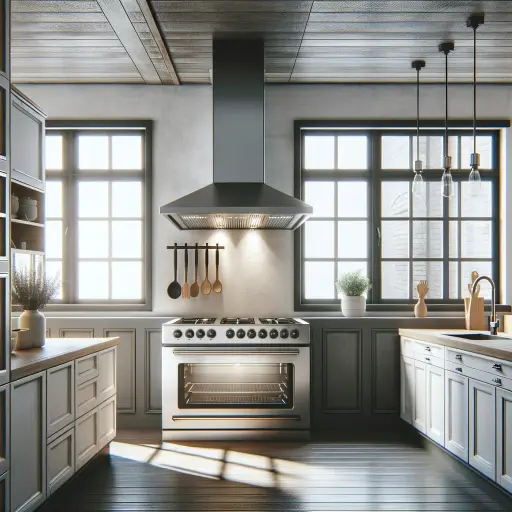
Monitor Stove Operation
- Keep an eye on your stove during operation for any signs of overheating, such as excessive heat radiating from the stovetop or oven, burning smells, or malfunctioning control panels.
- If overheating is detected, immediately turn off the stove and allow it to cool down before further investigation.
Repair or replace faulty components
- If you identify any damaged components during troubleshooting, consider repairing or replacing them to restore your stove’s functionality.
- This may include replacing worn-out heating elements, faulty thermostats, or damaged control panels.
Adjust stove settings for optimal performance
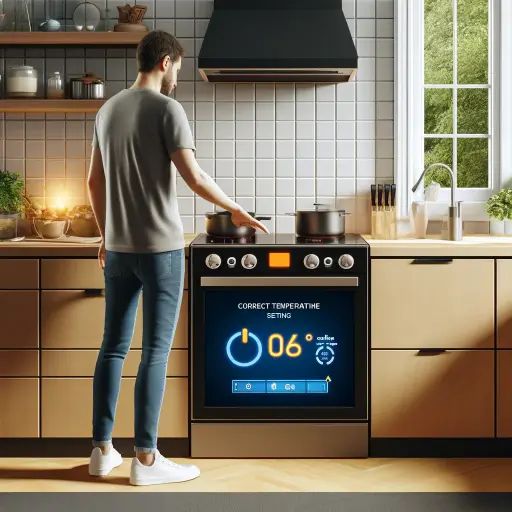
- Experiment with different temperature settings and cooking techniques to optimize performance and reduce the risk of overheating.
- Use lower heat settings for longer cooking times and avoid overcrowding the stove with too many pots.
Professional Maintenance and Repairs

- Schedule regular maintenance inspections with qualified repair technicians to ensure the optimal performance and safety of your stove.
- In case of persistent overheating issues or complex repairs, seek professional assistance for a thorough diagnosis.
- Consider replacing worn-out or faulty stove components, such as heating elements or control panels, to prevent future overheating issues.
Regular Cleaning and Maintenance
- Establish a routine cleaning schedule to remove grease, food residue, and debris that contribute to overheating. [Click here for electric stove maintenance tips].
- Use mild detergents and warm water to clean stove components thoroughly. Pay close attention to vents, burners, and heating elements to ensure optimal airflow.
Troubleshooting Guide
When faced with electric stove overheating issues, it’s essential to troubleshoot and find solutions to ensure safety. Here’s a complete guide.
Step-by-step Guide
- Checking for ventilation blockages: Start by inspecting the vents and airflow pathways around your stove. Remove any obstructions such as food debris, grease buildup, or kitchen utensils that may be blocking the airflow.
- Inspecting and cleaning stove components: Next, thoroughly inspect your stove’s components, including the burners, heating elements, and oven cavity. Look for any signs of damage, wear, or malfunction.
- Testing and calibrating temperature controls: Use a thermometer to check the accuracy of your stove’s temperature controls. Test each burner and oven setting to ensure they maintain the desired temperatures accurately. If you notice inconsistencies, consider calibrating the temperature controls or seeking professional help.
- Addressing specific issues: If you encounter specific problems such as control panel overheating or burner unevenness, address them accordingly.
Preventive Measures and Safety Tips
Preventive measures
To prevent electric stoves from overheating, it’s essential to adopt the following preventive measures:
- One of the most effective ways to prevent electric stove overheating is to maintain cleanliness. Schedule periodic maintenance checks to inspect for any signs of malfunction in stove components.
- Adequate ventilation is crucial for preventing the buildup of hot air around the stove. Make sure your kitchen has sufficient ventilation, such as range hoods or exhaust fans to prevent overheating.
- Choose cookware with flat bottoms that make direct contact with the stove’s heating elements for optimal heat transfer. Avoid using warped or damaged cookware, as it can cause uneven heating.
- Overloading electric stoves with heavy pots and pans can also lead to overheating. Distribute the weight evenly across the stove surface and avoid placing excessively heavy pots on one burner.
- Keep an eye on your cooking times and temperatures to prevent overheating. Avoid leaving food unattended on the stove, as this can lead to overheating.
Safety Tips and Recommendations
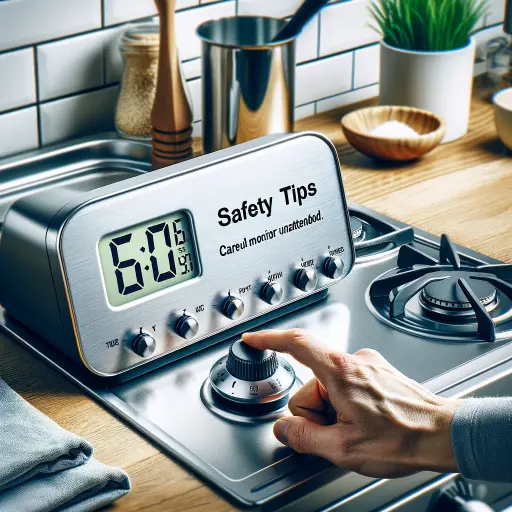
Here are some important safety tips and recommendations to follow:
- If you suspect your electric stove is overheating, turn it off immediately and disconnect it from the power source.
- Avoid touching any hot surfaces or components of the stove to prevent burns or injuries.
- Open windows or turn on exhaust fans to improve airflow and dissipate heat from the kitchen.
- Ensure flammable materials are kept away from the stove to reduce fire hazards.
- Have a fire extinguisher nearby and know how to use it in case of emergency.
- If the situation escalates or you cannot resolve the issue, contact emergency services or a qualified technician for assistance.
Do follow electric stove safety guidelines: https://stovemastery.com/electric-stove-safety-guidelines/
Addressing Specific Issues
Overheating After Cleaning:
Trapped moisture or food residue post-cleaning can lead to overheating. Check for proper ventilation and remove any residual moisture or debris to reduce the issue.
Overheating While Not in Use:
This signals a potentially serious electrical issue. Immediately disconnect the stove and seek professional repair to address this problem.
Safeguarding Against Overheating Risks
Exploring the effects of overheating can lead to a deeper understanding of the issue. Here are some areas worth exploring:
Influence of stove design on overheating:
Investigating how different stove designs, such as coil versus smooth-top electric stoves affect overheating tendencies can provide valuable insights. Understanding how stove design influences heat distribution, ventilation, and overall performance can help manufacturers develop safer stove models.
Effectiveness of advanced temperature control technologies:
Advanced temperature control technologies, such as smart sensors, thermostats, and induction cooking, promise to improve stove performance and energy efficiency while reducing the risk of overheating.
Conclusion
Addressing electric stove overheating is essential for maintaining a safe and efficient cooking environment. By implementing the preventive measures outlined in this blog post and staying aware of signs of overheating, readers can minimize the risk of accidents. It’s crucial to prioritize safety and proactive maintenance to prevent potential hazards.
We encourage readers to take the necessary steps to implement preventive measures and seek professional assistance if needed. Remember, safety should always come first in the kitchen. By following best practices for stove maintenance and safety, you can enjoy worry-free cooking experiences for years to come.
References
https://www.mrappliance.com/residential/appliance-repair/ranges-and-stove-tops/
https://www.smartappliance.co.za/2022/11/16/stove-safety-precautions
